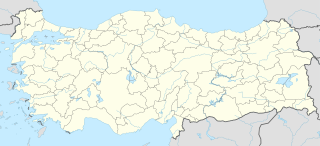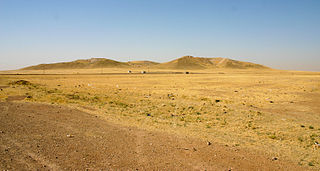 W
WThe Halaf culture is a prehistoric period which lasted between about 6100 BC and 5100 BC. The period is a continuous development out of the earlier Pottery Neolithic and is located primarily in the fertile valley of the Khabur River, of south-eastern Turkey, Syria, and northern Iraq, although Halaf-influenced material is found throughout Greater Mesopotamia.
 W
WArd Tlaili or Tell Ard Tlaili is a small tell mound archaeological site in a plain at the foot of the Lebanon Mountains 11 km (7 mi) northwest of Baalbeck, in the Beqaa Valley in Lebanon.
 W
WTell Arpachiyah is a prehistoric archaeological site in Nineveh Province (Iraq). It takes its name from a more recent village located about 4 miles (6.4 km) from Nineveh. The proper name of the mound on which the site is located is Tepe Reshwa.
 W
WChagar Bazar is a tell, or settlement mound, in northern Syria.
 W
WCoba Höyük, also known as Sakçe Gözü or Sakçagözü, is an archaeological site in southeastern Anatolia. It is located about three kilometres north-west of the modern village of Sakçagözü. The site was occupied in the Pottery Neolithic, Halaf, Ubaid, Late Chalcolithic/Uruk and Neo-Hittite periods.
 W
WDomuztepe was a large, late Neolithic settlement in south east Turkey, occupied at least as early as c.6,200BC and abandoned c.5,450BC. The site is located to the south of Kahramanmaraş. Covering 20 hectares, it is primarily a Halaf site of the 6th millennium BC and is the largest known settlement of that date.
 W
WGodin Tepe is an archaeological site in western Iran, situated in the valley of Kangavar in Kermanshah Province. Discovered in 1961, the site was excavated from 1965 to 1973 by a Canadian expedition headed by T. Cuyler Young Jr. and sponsored by the Royal Ontario Museum. The importance of the site may have been due to its role as a trading outpost in the early Mesopotamian trade networks.
 W
WHacilar is an early human settlement in southwestern Turkey, 23 km south of present-day Burdur. It has been dated back 7040 BC at its earliest stage of development. Archaeological remains indicate that the site was abandoned and reoccupied on more than one occasion in its history.
 W
WThe Halaf-Ubaid Transitional period is a prehistoric period of Mesopotamia. It lies chronologically between the Halaf period and the Ubaid period. It is still a complex and rather poorly understood period. At the same time, recent efforts were made to study the gradual change from Halaf style pottery to Ubaid style pottery in various parts of North Mesopotamia.
 W
WKültəpə is a settlement dated from the Neolithic Age, a village and municipality in the Babek Rayon of Nakhchivan, Azerbaijan. It has a population of 1,859.
 W
WTell Aqab is an ancient Mesopotamian settlement located in northeastern Syria, occupied from the early Halaf period to c. 3800 BCE. It is situated at the northern edge of the Khabur Plain near the headwaters of the Khabur tributary of the Euphrates, 6 km south-southeast of the town of Amuda in Jazira Canton. It is one of the few sites that contain material relating to the Halaf-Ubaid Transitional period, c. 5500–5000 BCE.
 W
WTell Bazmusian is an archaeological site on the right bank of the Little Zab in the Ranya Plain. The site was excavated between 1956 and 1958 by Iraqi archaeologists as part of a salvage operation to document cultural remains that would be flooded by Lake Dukan, the reservoir created by the Dukan Dam which was being built at that time. Apart from Tell Bazmusian, four other sites were excavated during this operation: ed-Dem, Kamarian, Qarashina and Tell Shemshara. Bazmusian is a tell, or settlement mound, with a circumference of 1,500 metres (4,900 ft) and a height of 23 metres (75 ft). Together with Tell Shemshara, it is one of the largest archaeological sites in the Ranya Plain. When the excavations started, the southeast flank of the mound was occupied by a village that was only established at the beginning of the 20th century. The site is now submerged under Lake Dukan.
 W
WTell Brak was an ancient city in Syria; its remains constitute a tell located in the Upper Khabur region, near the modern village of Tell Brak, 50 kilometers north-east of Al-Hasaka city, Al-Hasakah Governorate. The city's original name is unknown. During the second half of the third millennium BC, the city was known as Nagar and later on, Nawar.
 W
WTell Halaf is an archaeological site in the Al Hasakah governorate of northeastern Syria, near the Turkish border, just opposite Ceylanpınar. The site, which dates to the 6th millennium BCE, was the first to be excavated from a Neolithic culture, later called the Halaf culture, characterized by glazed pottery painted with geometric and animal designs.
 W
WTell Halula is a large, prehistoric, neolithic tell, about 8 hectares (860,000 sq ft) in size, located around 105 kilometres (65 mi) east of Aleppo and 25 kilometres (16 mi) northwest of Membij in the Raqqa Governorate of Syria.
 W
WTell Sabi Abyad is an archaeological site in the Balikh River valley in northern Syria. The site consists of four prehistoric mounds that are numbered Tell Sabi Abyad I to IV. Extensive excavations showed that these sites were inhabited already around 7500 to 5500 BC, although not always at the same time; the settlement shifted back and forth between these four sites.
 W
WTepe Gawra is an ancient Mesopotamian settlement in the Mosul region of northwest Iraq that was occupied between 5000 and 1500 BC. It contains remains from the Halaf period, the Ubaid period, and the Uruk period. Tepe Gawra contains material relating to the Halaf-Ubaid Transitional period c. 5,500–5,000 BC.
 W
WYarim Tepe is an archaeological site of an early farming settlement that goes back to about 6000 BC. It is located in the Sinjar valley some 7km southwest from the town of Tal Afar in northern Iraq. The site consists of several hills reflecting the development of the Hassuna culture, and then of the Halaf and Ubaid cultures.